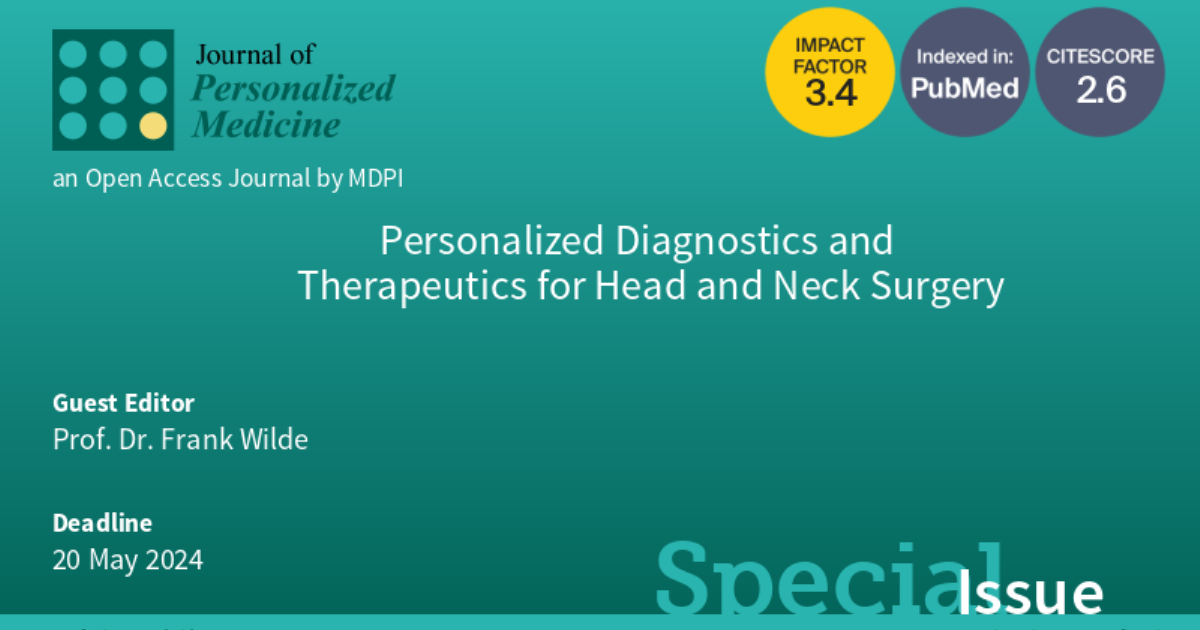- 6.0CiteScore
- 22 daysTime to First Decision
Personalized Diagnostics and Therapeutics for Head and Neck Surgery
This special issue belongs to the section “Personalized Therapy and Drug Delivery“.
Special Issue Information
Dear Colleagues,
In recent years, advances in computer-assisted surgery have made it increasingly possible to offer personalized reconstructions to patients undergoing head and neck surgery. Reconstructions with patient-specific implants and surgical templates must be mentioned specifically in this context. In this respect, further developments should now focus on decreasing the workflow and, above all, increasing user friendliness and the faster availability of individual solutions.
However, new knowledge in the field of personalized diagnostics with regard to potential prognostic factors and personalized (non-)surgical therapy approaches for head and neck oncology is an exciting and forward-looking topic of research.
With this Special Issue, authors are invited to present their most recent developments and findings in personalized diagnostics and therapy in the field of head and neck surgery.
Prof. Dr. Frank Wilde
Guest Editor
Manuscript Submission Information
Manuscripts should be submitted online at www.mdpi.com by registering and logging in to this website. Once you are registered, click here to go to the submission form. Manuscripts can be submitted until the deadline. All submissions that pass pre-check are peer-reviewed. Accepted papers will be published continuously in the journal (as soon as accepted) and will be listed together on the special issue website. Research articles, review articles as well as short communications are invited. For planned papers, a title and short abstract (about 250 words) can be sent to the Editorial Office for assessment.
Submitted manuscripts should not have been published previously, nor be under consideration for publication elsewhere (except conference proceedings papers). All manuscripts are thoroughly refereed through a single-blind peer-review process. A guide for authors and other relevant information for submission of manuscripts is available on the Instructions for Authors page. Journal of Personalized Medicine is an international peer-reviewed open access monthly journal published by MDPI.
Please visit the Instructions for Authors page before submitting a manuscript. The Article Processing Charge (APC) for publication in this open access journal is 2600 CHF (Swiss Francs). Submitted papers should be well formatted and use good English. Authors may use MDPI's English editing service prior to publication or during author revisions.
Keywords
- head and neck surgery
- head and neck oncology
- personalized diagnostics
- personalized therapy
- computer-assisted surgery
- patient-specific implants
- navigation

Benefits of Publishing in a Special Issue
- Ease of navigation: Grouping papers by topic helps scholars navigate broad scope journals more efficiently.
- Greater discoverability: Special Issues support the reach and impact of scientific research. Articles in Special Issues are more discoverable and cited more frequently.
- Expansion of research network: Special Issues facilitate connections among authors, fostering scientific collaborations.
- External promotion: Articles in Special Issues are often promoted through the journal's social media, increasing their visibility.
- e-Book format: Special Issues with more than 10 articles can be published as dedicated e-books, ensuring wide and rapid dissemination.

